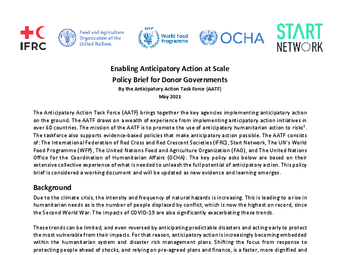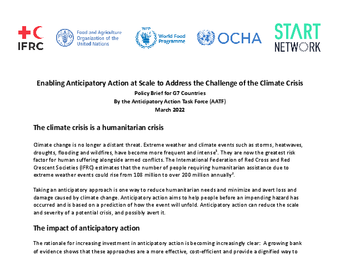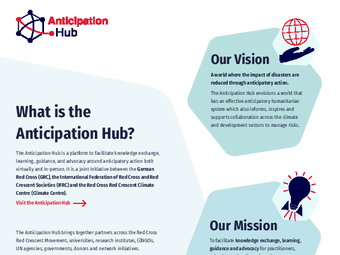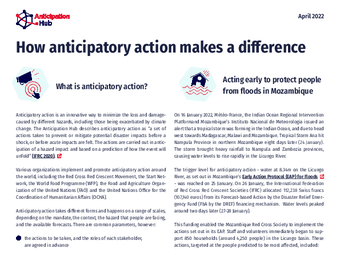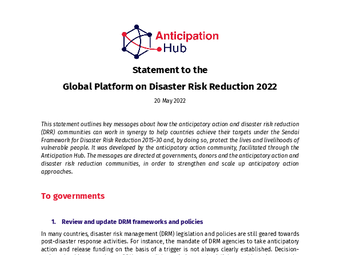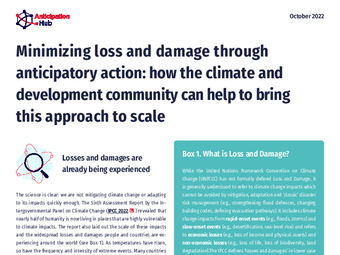Categories
Key Messages
This section includes key policy and advocacy messages that can be used by the Anticipation Hub’s community of users to help them make the case for scaling up anticipatory action.
Please consider incorporating these messages into your work-including reports, blogs and external events, and adapting these messages so that they are appropriate for your context.
Key policy and advocacy messages will be updated regularly as new evidence emerges from our programmes and policies develop.
The Anticipation Hub also informs and amplifies key policy messages developed by other initiatives, such as the Anticipatory Action Task Force. Please get in touch if you have key policy and advocacy messages that could be included here.
Why are we advocating for anticipatory action?
Most disasters are nor unpredictable. Treating them as such leads to critical opportunities to save lives and build long-term resilience being missed. Despite improvements in abilities to predict the likelihood of disasters, the humanitarian system continues to react as though disasters are unexpected surprises, responding only after they occur, and then often slowly. Meanwhile lives and livelihoods are lost.
One of the biggest, systemic problems that the humanitarian sector faces is slow and reactive funding. For every $10 spent on humanitarian relief, only $1 is spent on reducing and managing risks. [Start Network 2019 DRF In Concert]
We need, can and must do better. We want to see a humanitarian system that saves more lives by center-staging anticipation instead of reaction. We want to prevent the potential disaster impacts prior to a shock by carrying actions prior of a hazard impact and based on a prediction how the event will unfold and supported by predicable financing.
We want to do so because anticipation saves lives and livelihoods and reduces human suffering. There is growing evidence of the multiple benefits of anticipatory action. Our recent policy brief ‘How anticipatory action makes a difference’ highlights some of these, while our evidence database provides all the latest findings from anticipatory action initiatives around the world.
Read more here: The Evidence Base on Anticipatory Action.
Successful system change cannot be done alone. Anticipatory approaches have gained significant momentum over the last years. In over 60 actors have started to make use of anticipatory actions to mitigate the impact of disasters. Despite being a great achievement, the total number of people covered is still limited.
Achieving the change needed requires greater efforts. We are aiming to catalyze change by strengthening Early Warning Systems and impact-based forecasting, shifting humanitarian financing from a reactive to a proactive model, stimulating collective innovation, and facilitating coordination to solve humanitarian problems locally and globally.
How can we scale up?
Collaborate on creating evidence, knowledge sharing and learning activities
We can all learn from each other. Reach out to and get involved in the Anticipation Hub and other exchange forum to improve evidence and knowledge so that anticipatory action is fast, appropriate and effective.
Promote a coordinated approach, facilitate and leverage partnerships
We are stronger and better together. Anticipatory approaches vary considerably. They address different hazards, different target groups and are based on operational modalities. We see diversity as a strength. Leverage technical expertise and partnerships to promote a coherent and coordinated approach to anticipatory action, at global, regional and national levels. Read more here: Start Network 2019 DRF In Concert.

Dedicate more funds to expand anticipatory action
Support fast, flexible and predictable funding. Allow humanitarian agencies to manage and respond to emerging risks. Despite the growing evidence of the benefits of investment in preparedness, anticipation and early response, predictable funding released based on pre-agreed triggers or plans through regional risk pools and early action systems is equivalent to less than 1% of the UN appeals. Read more here: ODI/Start Network 2019: Analysing Gaps in the humanitarian and disaster risk financing landscape.
In line with the objectives of the World Humanitarian Summit 2016, support a system-wide shift towards more predictable and rapid financing to stop disasters from devastating lives. Dedicate more funds to expand anticipatory action so that a greater number of people can receive assistance ahead of predictable shocks. Anticipatory action is needed more than ever as we face escalating humanitarian needs associated with the impacts of climate change. Read more here: IFRC Cost of doing nothing report 2019.
Existing humanitarian funding should not be diverted to COVID-19 but should be provided in addition. Humanitarian crises and natural hazards do not stop because of a pandemic. Quite the opposite, COVID-19, in combination with other hazards such as droughts, storms, conflicts might lead to compound risks.
Make more and better investments in Early Warning Systems
Strengthen hydromet services. While investments in climate services and early warning systems have substantially increased over the past decade, both more and better investments are needed to address data and capacity gaps. Investments are not yet flowing into the areas where needs and gaps are the greatest.
Make the last mile the first mile and create people-centered early warning systems. Support hydromet services in the development of impact-based forecasting products. Involve first responders, humanitarian in development of products and services at the country level to ensure that warnings reach those it wants to reach: communities it risk. See WMO State of Climate Service Report 2019.
Research shows that investments in Early Warning Systems have the highest benefit-cost ratio of any adaptation investment. Effective early warning systems can cut the ensuing damage by 30 percent, and spending $800 million on such systems in developing countries would avoid losses of $3–16 billion per year. See Global Commission on Adaptation Report 2019.
Support local actors to access funds and give them a greater role in DRM strategies
Local civil society and humanitarian organisations such as National Red Cross and Red Crescent Societies have a crucial role to play in managing disaster risks. They understand the complexities and the risks of any given community or region better than any other actor. But they have to be resourced. Support them with to access pre-positioned funds and enable them to assume a clearer role within national DRM/early action strategies.
The boundaries between sustainable development, climate change adaptation and disaster risk management have always been artificial. What unites all three fields of action is to reduce the impacts of threatening disasters. Change procedures so that development and multilateral climate funds are accessible by local actors to strengthen disaster preparedness, including anticipatory action.
Integrate anticipatory action in DRM strategies, policies and plans
Review DRM laws, policies and plans by including support for anticipatory action. This could be done by including anticipatory action in existing disaster preparedness or response funds or scaling up social protection schemes.
Strengthen the mandate of hydromet services and invest in early warning systems that are fit-for-context
Invest and design integrated early warning and early action systems, that assure timely delivery of actionable warnings and an adequate protective response.
Identify opportunities for and set up a coordinated disaster risk financing system at the national level
Work closely with humanitarian partners such as CSOs, the Red Cross Red Crescent and the UN to develop disaster risk financing strategy that leaves no-one behind. To date, disaster risk financing tools (such as emergency funds, risk pools, cat bonds, FbF) have developed in isolation along traditional humanitarian-development divides. Develop a joint disaster risk strategy where all partners work together to share data and analysis to quantify risk in advance, pre-position funds and release them in a coordinated way according to aligned plans. Read more here: Start Network 2019 DRF In Concert.
Targeted key policy and advocacy messages
The Anticipation Hub is the process of co-creating targeted key messages for diverse stakeholders influencing different components of anticipatory action. This includes donors, national governments, hydro-meteorological services, universities and research institutions, humanitarian actors and community-based organisations. We will also explore more thematic based messaging for specific policy domains or topics such as innovative disaster risk financing.
The following five key policy asks were developed by the Anticipatory Action Task Force in the form of a video and policy brief targeting donor governments.
Anticipatory Action 5 Key Policy Asks
The key policy asks in this video are based on their extensive collective experience of what is needed to unleash the full potential of anticipatory action.
Play Video
Do you have a question?
Nikolas Scherer, PhD.
Advisor for Policy and Advocacy on Anticipation and Disaster Risk FinancingGerman Red Cross
Raise your Question

